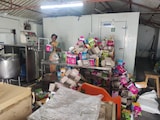In Gaza, Parle-G biscuits, a childhood staple in India, are now sold for over 24 euros amid severe food scarcity, marking a 500-fold price increase.
Parle-G biscuits, a staple in Indian households, associated with childhood, tea breaks, and low-cost nutrition, were never intended to be a luxury. But in wartorn Gaza, where food scarcity has turned into acute famine, they are being sold at nearly 500 times their original price.
In a recent viral post from Gaza, a man claimed that Parle G biscuits, manufactured by Mumbai-headquartered Parle Products, are being sold for over 24 euros (Rs 2,342). Many on social media were baffled by the cost of the biscuits that have consistently been among the cheapest foods in the Indian market.
"After a long wait, I finally got Ravif her favorite biscuits today. Even though the price jumped from 1.5 euros to over 24 euros, I just couldn't deny Rafif her favorite treat," the viral post read.
A Manufactured Famine
Following the October 2023 escalation and Israel's military campaign that began shortly thereafter, Gaza's access to food has been systematically reduced. Between March 2 and May 19 this year, the besieged Palestinian enclave faced a near-total blockade. Only a limited number of humanitarian trucks were allowed through, most of them after intense international pressure.
Israel, which accuses Hamas, the political and militant group within Gaza, of seizing and weaponising aid, had suspended traditional UN food deliveries. Instead, a controversial and heavily criticised alternative was introduced on May 27 - the Secure Distribution Site 1 (SDS1) model, developed by the Gaza Humanitarian Foundation (GHF), which, according to the French daily Le Monde, is a joint initiative backed by the US, Switzerland, and Israel.
The SDS1, located in Rafah, features caged corridors forcing Palestinians into narrow queues, guarded perimeters manned by Safe Reach Solutions, a US-based private security firm, which has been accused of carrying out intelligence operations in Gaza using Israeli data.
But how much aid reaches the truly hungry? How many aid boxes are being sold on the black market for inflated prices?
The Black Market Reality
The steep pricing is not limited to Parle-G, which is an export from a country located roughly 4,300 km away.
"The problem isn't with the original suppliers or taxation," Dr. Khaled Alshawwa, a 31-year-old surgeon based in Gaza City, told NDTV. "These goods usually enter Gaza as humanitarian aid, free of charge. But only a minority receives them. Scarcity turns them into high-priced black market goods."
Mr Alshawwa managed to get his hands on a packet of Parle-G biscuits, which he said cost him roughly Rs 240 and not over Rs 2,000 like in some places. Different locations, different prices depending on who the seller is. Interestingly, these Parle-G packets, with 'EXPORT PACK' labels, do not mention any price whatsoever.
"The closure of borders for more than three months now has allowed only a scarce amount of very basic needs that don't meet the needs of 2 million people. So when some people are able to get some, or when looting happens, these foods are being sold at very high, unaffordable prices." Dr Alshawwa told NDTV.
Parle-G, it appears, likely arrived through aid shipments, eventually landing in the hands of a few vendors who sold it at prices unreachable to most Gazans. NDTV has reached out to the company for a statement.
A rough breakdown of current market prices (in INR) of some important products from northern Gaza as of June 6, 2025:
1 kg sugar: Rs 4,914
1 litre cooking oil: Rs 4,177
1 kg potatoes: Rs 1,965
1 kg onions: Rs 4,423
1 coffee cup: Rs 1,800
A list sourced by NDTV from Gaza shows basic commodities and groceries being sold at exorbitant prices. The prices are mentioned in the new Israeli shekel. the local currency. One Israeli shekel translates to 24.57 Indian rupees
Guy Nir, spokesperson of the Israeli embassy in India, reacted to the inflated rate of the biscuits, saying, "This is why free humanitarian aid directly to the people of Gaza is so important."
"Because over 80% of products in all previous aid attempts were looted by Hamas, and resold to the Gazans for an outrageous price," he claimed.
Why Parle-G Matters
Parle-G is more than food. It is nostalgia wrapped in paper. Launched in 1938, the biscuit emerged during India's Swadeshi movement as a local alternative to elite British snacks. It became a national equaliser, a biscuit anyone could afford.
Over the decades, Parle-G has managed to retain its low price tag thanks to 'shrinkflation' economics - reducing weight while maintaining price. A Rs 5 packet that once held 100 grams now contains about 55 grams. Still, it remains among the cheapest packaged food products in India.
In 2013, Parle-G became the first Indian FMCG brand to cross Rs 5,000 crore in sales. By 2011, it was the world's largest selling biscuit by volume, according to Nielsen.















